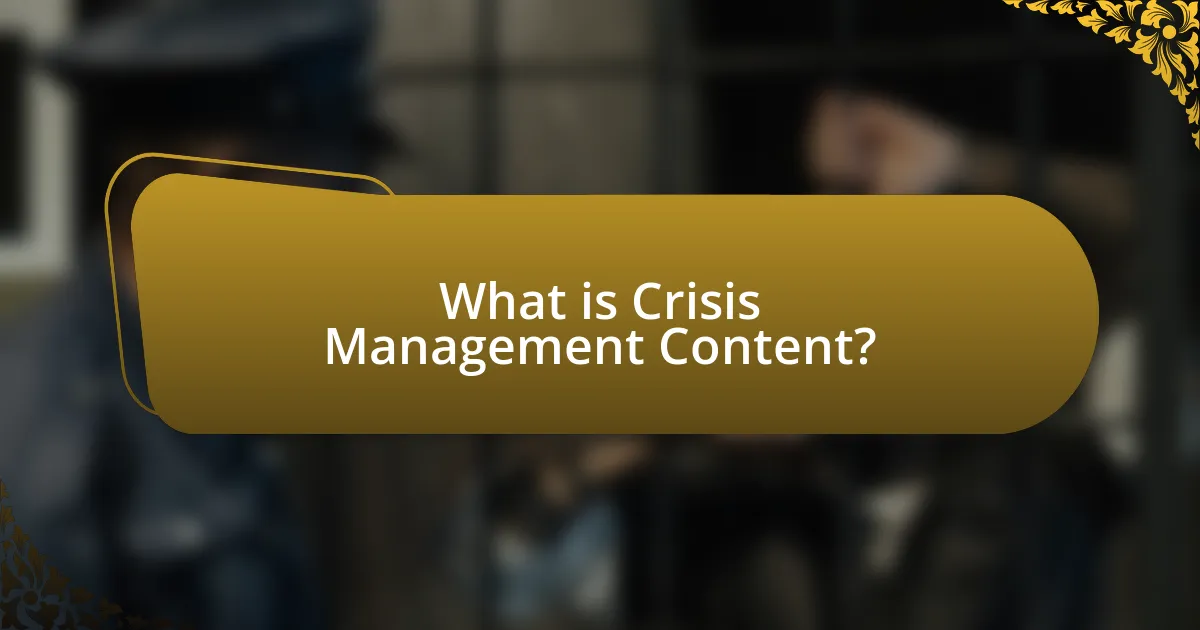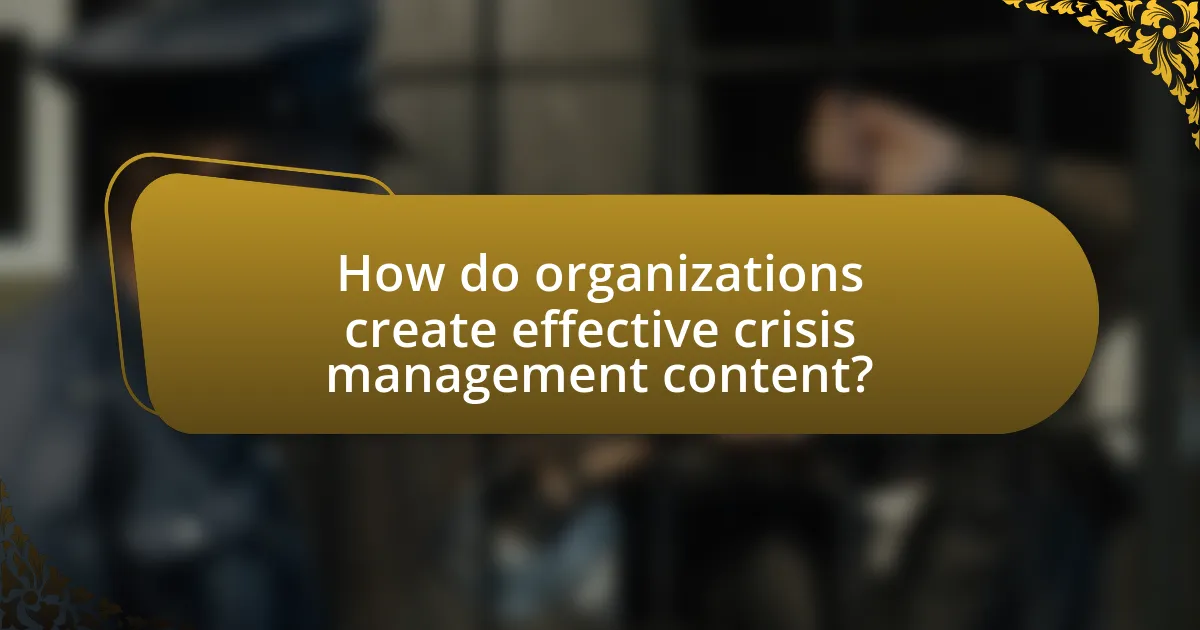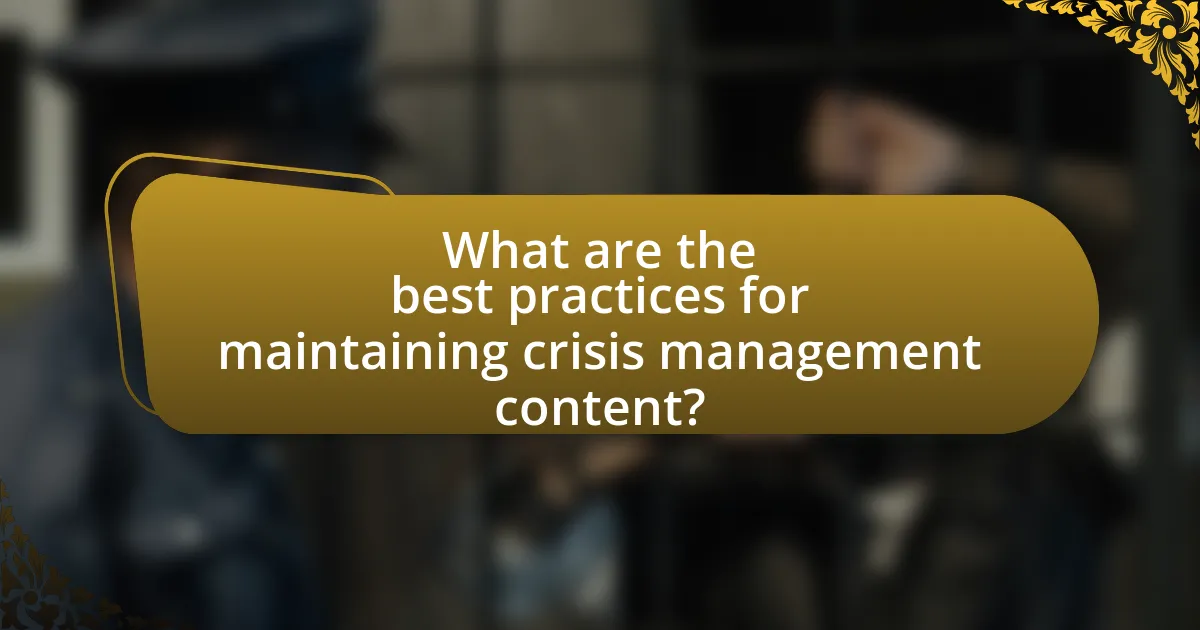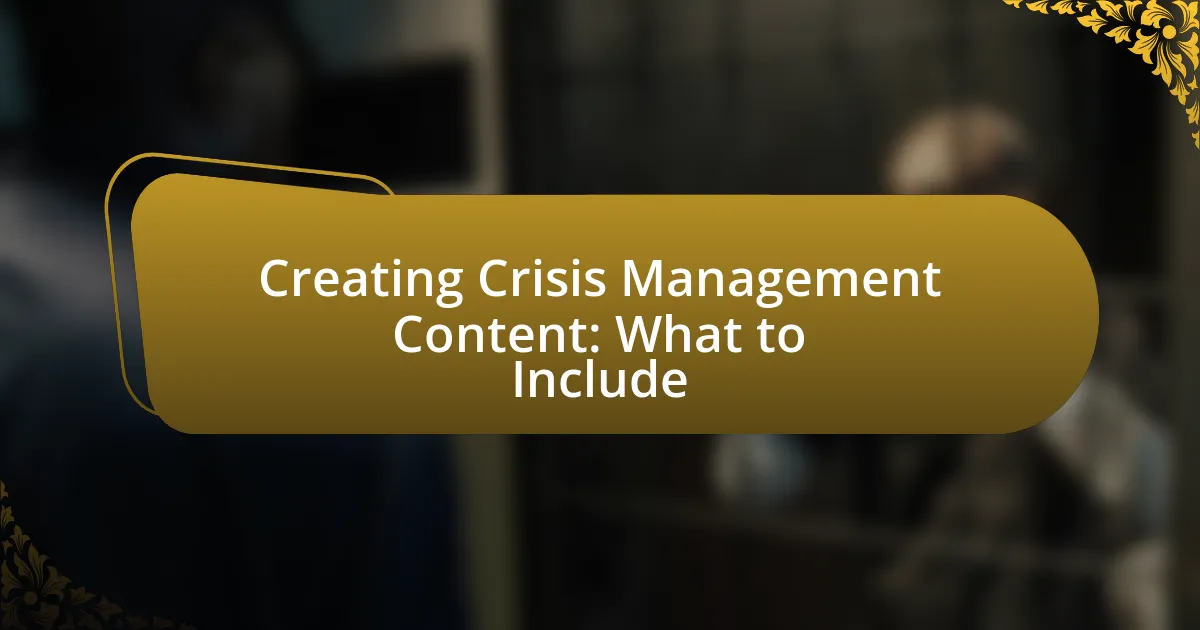Crisis management content encompasses the materials and strategies organizations develop to communicate effectively during emergencies. This article outlines the importance of such content, emphasizing its role in minimizing damage, maintaining trust, and enhancing organizational resilience. Key components include clear communication protocols, timely updates, and actionable guidance tailored to specific audiences. The article also discusses best practices for creating and maintaining crisis management content, the significance of stakeholder input, and the use of technology and training to improve response effectiveness. Additionally, it highlights common pitfalls to avoid and practical tips for enhancing engagement through storytelling and clarity.

What is Crisis Management Content?
Crisis management content refers to the information and materials developed to effectively communicate during a crisis situation. This type of content includes crisis communication plans, press releases, social media updates, and FAQs that provide clear, accurate, and timely information to stakeholders. The purpose of crisis management content is to mitigate damage, maintain trust, and guide the organization’s response to the crisis, ensuring that all communications are consistent and aligned with the organization’s values and objectives.
Why is Crisis Management Content important for organizations?
Crisis Management Content is important for organizations because it provides a structured approach to effectively respond to emergencies, minimizing damage and ensuring continuity. This content equips organizations with clear protocols, communication strategies, and action plans that can be quickly implemented during a crisis. For instance, a study by the Institute for Crisis Management found that organizations with a crisis management plan are 50% more likely to recover quickly from a crisis compared to those without one. This highlights the necessity of having well-prepared content to guide decision-making and maintain stakeholder trust during challenging situations.
What are the potential consequences of inadequate crisis management content?
Inadequate crisis management content can lead to severe consequences, including miscommunication, reputational damage, and operational disruptions. Miscommunication during a crisis can result in the dissemination of incorrect information, which may exacerbate the situation and confuse stakeholders. For instance, a study by the Institute for Crisis Management found that 70% of organizations that failed to communicate effectively during a crisis experienced significant reputational harm. Additionally, operational disruptions can occur when teams lack clear guidelines, leading to inefficient responses and prolonged recovery times. The lack of structured content can also hinder decision-making processes, as employees may not know their roles or the appropriate actions to take.
How does effective crisis management content enhance organizational resilience?
Effective crisis management content enhances organizational resilience by providing clear guidelines and strategies that enable organizations to respond swiftly and effectively to crises. This content equips employees with the knowledge and tools necessary to navigate challenges, thereby minimizing disruption and maintaining operational continuity. Research indicates that organizations with well-defined crisis management plans experience 30% less downtime during crises compared to those without such plans, demonstrating the direct impact of effective content on resilience.
What are the key components of effective crisis management content?
The key components of effective crisis management content include clear communication, timely updates, and actionable guidance. Clear communication ensures that the message is easily understood, which is critical during a crisis when emotions run high and misinformation can spread rapidly. Timely updates keep stakeholders informed about the evolving situation, fostering trust and transparency. Actionable guidance provides specific steps for individuals to take, helping them navigate the crisis effectively. Research indicates that organizations that prioritize these components are more successful in managing crises and maintaining public confidence. For instance, a study by the Institute for Crisis Management found that organizations with well-structured communication strategies are 50% more likely to recover their reputation post-crisis.
What types of information should be included in crisis management content?
Crisis management content should include clear communication protocols, roles and responsibilities, and a detailed action plan. Clear communication protocols ensure that all stakeholders receive timely and accurate information during a crisis, which is essential for effective response. Defining roles and responsibilities clarifies who is in charge of specific tasks, reducing confusion and enhancing coordination. A detailed action plan outlines the steps to be taken in response to various crisis scenarios, providing a structured approach to managing the situation. These elements are critical as they help organizations respond efficiently and minimize the impact of crises, supported by studies showing that effective crisis communication can significantly reduce reputational damage and recovery time.
How can organizations tailor their crisis management content to specific audiences?
Organizations can tailor their crisis management content to specific audiences by analyzing the demographics, needs, and preferences of each audience segment. This approach ensures that the content resonates with the audience’s values and concerns, enhancing engagement and effectiveness. For instance, research indicates that different age groups respond to various communication styles; younger audiences may prefer digital platforms and concise messaging, while older audiences might favor detailed reports and traditional media. By utilizing audience segmentation techniques, organizations can create targeted messages that address specific fears or questions relevant to each group, thereby improving the overall impact of their crisis communication efforts.

How do organizations create effective crisis management content?
Organizations create effective crisis management content by developing clear, concise, and actionable communication strategies tailored to their audience. This involves identifying key messages, establishing a communication plan, and utilizing various channels to disseminate information promptly. For instance, a study by the Institute for Crisis Management highlights that organizations that prepare detailed crisis communication plans are 50% more likely to manage crises effectively. Additionally, incorporating real-time updates and feedback mechanisms ensures that the content remains relevant and responsive to the evolving situation.
What steps should be taken to develop crisis management content?
To develop crisis management content, organizations should follow a structured approach that includes identifying potential crises, assessing risks, creating a communication plan, and training staff. First, identifying potential crises involves analyzing past incidents and current vulnerabilities to anticipate future challenges. For example, a study by the Institute for Crisis Management found that 70% of crises are predictable, emphasizing the importance of proactive identification.
Next, assessing risks entails evaluating the likelihood and impact of identified crises, which helps prioritize response strategies. Following this, creating a communication plan is crucial; it should outline key messages, target audiences, and communication channels to ensure timely and effective dissemination of information during a crisis. Research indicates that organizations with a well-defined communication strategy are 50% more likely to manage crises successfully.
Finally, training staff on crisis response protocols ensures that all team members are prepared to act swiftly and effectively when a crisis occurs. Regular drills and updates to the crisis management plan based on feedback and changing circumstances further enhance readiness. By implementing these steps, organizations can create robust crisis management content that effectively addresses potential challenges.
How can organizations assess their current crisis management content?
Organizations can assess their current crisis management content by conducting a comprehensive review of existing materials, evaluating their relevance, effectiveness, and alignment with best practices. This assessment involves analyzing the clarity of communication, the adequacy of response strategies, and the incorporation of lessons learned from past crises. For instance, a study by the International Association of Business Communicators found that organizations with regularly updated crisis plans are 50% more effective in managing crises than those without. This highlights the importance of not only reviewing content but also ensuring it is current and actionable.
What role does stakeholder input play in creating crisis management content?
Stakeholder input is crucial in creating crisis management content as it ensures that the information is relevant, accurate, and addresses the concerns of all parties involved. Engaging stakeholders allows organizations to gather diverse perspectives, which can enhance the effectiveness of the crisis response strategy. For instance, a study by Coombs (2014) highlights that incorporating stakeholder feedback leads to more comprehensive crisis plans that are better aligned with public expectations and needs. This alignment not only improves communication during a crisis but also fosters trust and credibility among stakeholders, ultimately contributing to a more effective crisis management process.
What tools and resources can assist in creating crisis management content?
Tools and resources that assist in creating crisis management content include crisis communication plans, social media monitoring tools, and content management systems. Crisis communication plans provide structured guidelines for messaging during emergencies, ensuring consistency and clarity. Social media monitoring tools, such as Hootsuite or Brandwatch, enable organizations to track public sentiment and respond swiftly to emerging issues. Content management systems like WordPress or HubSpot facilitate the efficient creation and dissemination of crisis-related content, allowing for timely updates and information sharing. These tools collectively enhance the effectiveness of crisis management strategies by streamlining communication and ensuring accurate information delivery.
How can technology enhance the development of crisis management content?
Technology can enhance the development of crisis management content by enabling real-time data analysis and communication. Advanced analytics tools allow organizations to assess risks and gather insights from social media, news outlets, and other data sources, facilitating timely and relevant content creation. For instance, platforms like Hootsuite and Google Alerts can monitor public sentiment and emerging issues, ensuring that crisis management content is informed by current events. Additionally, collaboration tools such as Slack and Microsoft Teams streamline communication among stakeholders, allowing for rapid content updates and dissemination during a crisis. This integration of technology not only improves the accuracy of the information but also enhances the responsiveness of organizations in managing crises effectively.
What are some examples of effective crisis management content templates?
Effective crisis management content templates include the Crisis Communication Plan Template, which outlines key messages, target audiences, and communication channels; the Incident Report Template, which captures details of the crisis, actions taken, and outcomes; and the Stakeholder Communication Template, designed for tailored messaging to specific groups affected by the crisis. These templates are validated by their widespread use in organizations during crises, ensuring structured and efficient communication, which is critical for maintaining trust and transparency.

What are the best practices for maintaining crisis management content?
The best practices for maintaining crisis management content include regular updates, stakeholder engagement, and thorough documentation. Regular updates ensure that the content reflects the most current information and strategies, which is crucial during a crisis when timely and accurate information is essential. Engaging stakeholders, such as team members and external partners, fosters collaboration and ensures that diverse perspectives are considered, enhancing the content’s relevance and effectiveness. Thorough documentation of processes and lessons learned from past crises provides a valuable reference for future situations, helping organizations to refine their strategies and improve response times. These practices are supported by research indicating that organizations with updated and well-documented crisis management plans are more effective in their responses, as highlighted in studies by the International Journal of Emergency Management.
How often should crisis management content be reviewed and updated?
Crisis management content should be reviewed and updated at least annually, or more frequently if significant changes occur within the organization or its environment. Regular reviews ensure that the content remains relevant and effective in addressing current risks and challenges. For instance, organizations that have experienced crises often find that their response plans need adjustments based on lessons learned, regulatory changes, or shifts in public perception. Therefore, an annual review, supplemented by updates after any major incident or change, is essential for maintaining the efficacy of crisis management strategies.
What indicators suggest that crisis management content needs revision?
Indicators that suggest crisis management content needs revision include outdated information, changes in organizational structure, and shifts in regulatory requirements. Outdated information can lead to ineffective responses during a crisis, as seen in the 2010 BP oil spill, where reliance on outdated protocols hindered effective management. Changes in organizational structure, such as mergers or leadership changes, necessitate updates to ensure alignment with current practices. Additionally, shifts in regulatory requirements, like the introduction of new compliance standards, require content revisions to maintain legal and operational effectiveness.
How can organizations ensure their crisis management content remains relevant?
Organizations can ensure their crisis management content remains relevant by regularly updating it based on emerging trends, stakeholder feedback, and real-world incidents. This approach involves conducting periodic reviews of the content to incorporate new data, case studies, and best practices that reflect current challenges and solutions in crisis management. For instance, a study by the International Association of Emergency Managers highlights that organizations that adapt their crisis plans to include lessons learned from recent crises are more effective in managing future incidents. By actively engaging with industry experts and utilizing analytics to assess the effectiveness of their content, organizations can maintain its relevance and applicability in a rapidly changing environment.
What common pitfalls should be avoided when creating crisis management content?
Common pitfalls to avoid when creating crisis management content include lack of clarity, insufficient audience understanding, and failure to update information. Clarity is crucial; ambiguous language can lead to confusion during a crisis. Understanding the audience ensures that the content addresses their specific concerns and needs, which is vital for effective communication. Additionally, failing to update information can result in the dissemination of outdated or incorrect data, undermining trust and credibility. For instance, during the COVID-19 pandemic, organizations that provided timely updates were more effective in managing public perception and response.
What are the risks of using outdated information in crisis management content?
Using outdated information in crisis management content poses significant risks, including the potential for misinformation, ineffective response strategies, and loss of public trust. Misinformation can lead to incorrect actions being taken during a crisis, as seen in the 2003 SARS outbreak when outdated data contributed to panic and mismanagement. Ineffective response strategies arise when organizations rely on obsolete protocols that may not address current realities, as evidenced by the challenges faced during the COVID-19 pandemic when previous crisis plans were inadequate. Furthermore, loss of public trust occurs when stakeholders perceive that organizations are not providing accurate or timely information, which can exacerbate the crisis and hinder recovery efforts.
How can organizations prevent miscommunication in their crisis management content?
Organizations can prevent miscommunication in their crisis management content by implementing clear communication protocols and ensuring consistent messaging. Establishing a centralized communication team responsible for crafting and disseminating information helps maintain uniformity. Additionally, utilizing plain language and avoiding jargon enhances understanding among diverse audiences. Regular training sessions for staff on crisis communication best practices further solidify these efforts. Research indicates that organizations with structured communication strategies experience 50% fewer misunderstandings during crises, highlighting the effectiveness of these measures.
What practical tips can enhance the effectiveness of crisis management content?
To enhance the effectiveness of crisis management content, ensure clarity and conciseness in messaging. Clear communication reduces misunderstandings and allows stakeholders to quickly grasp essential information. For instance, using bullet points or numbered lists can help present critical information in an easily digestible format. Additionally, incorporating real-time updates is vital; research shows that timely information can significantly reduce panic and misinformation during a crisis. According to a study by the Pew Research Center, 64% of people expect organizations to provide timely updates during emergencies. Lastly, utilizing multiple communication channels, such as social media, email, and press releases, ensures that the content reaches a broader audience, thereby increasing its impact.
How can storytelling be used to improve crisis management content engagement?
Storytelling can improve crisis management content engagement by making complex information relatable and memorable. When narratives are used, they can humanize the crisis, allowing audiences to connect emotionally with the content. For instance, case studies that illustrate real-life experiences during crises can enhance understanding and retention of key messages. Research shows that stories are 22 times more memorable than facts alone, which underscores their effectiveness in engaging audiences during critical situations. By framing crisis information within a narrative structure, organizations can foster empathy and encourage proactive responses from their audience.
What role does training play in the successful implementation of crisis management content?
Training is essential for the successful implementation of crisis management content as it equips individuals with the necessary skills and knowledge to respond effectively during a crisis. Effective training ensures that team members understand their roles, the protocols to follow, and the content itself, which enhances coordination and reduces response time. Research indicates that organizations with comprehensive crisis management training programs experience a 30% improvement in response effectiveness compared to those without such training. This demonstrates that structured training not only prepares personnel but also significantly impacts the overall success of crisis management efforts.

Leave a Reply